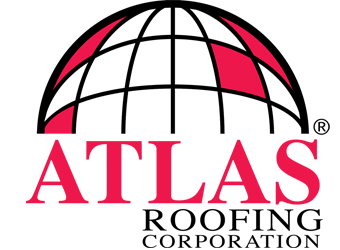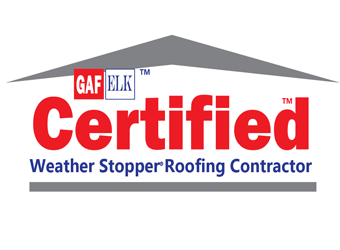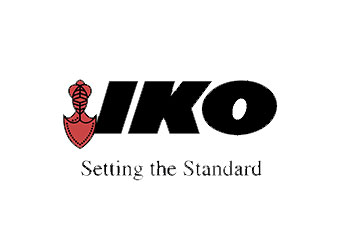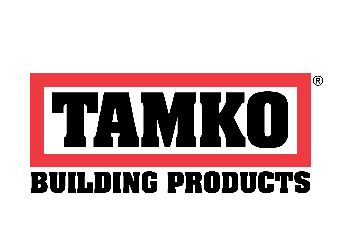Single Ply Roof Repair
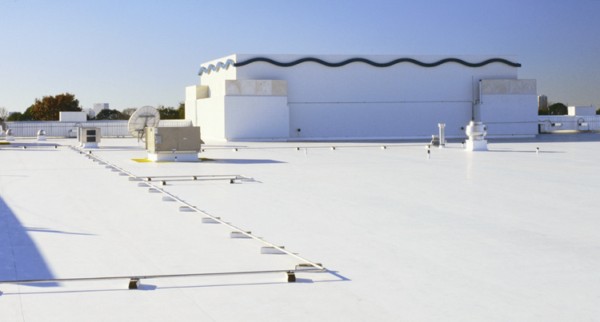
In need of a commercial roofing company that specializes in single-ply roof repair and roof replacement? Well, you’re in luck! GA Roofing & Repair, located in Atlanta and Alpharetta, is a fully licensed and certified installer of single-ply roof products. We’re backed by all major manufacturers and have the experience and expertise to handle any single-ply roofing project. Let us help you!
Single-ply Membrane Roof Repair & Proper MAINTENANCE ARE CRITICAL
Regardless of the roofing system you choose, proper installation and regular single-ply roof repair maintenance (including inspections) is a must. When searching for a roofing contractor, make sure the company you hire is trained to install the specific type of single-ply membrane that you are looking for. Contact the National Roofing Contractors Association or the membrane’s manufacturer for a list of approved applicators. “The other thing I recommend to owners is, if it’s possible, go out and visit a job – and I prefer that they visit a job in progress, not just a completed job. When you visit one in progress, you get to learn about the way the contractor sets up, cleans up, and manages the project,” advises Weber.
SINGLE-PLY ROOFing SYSTEMS: BENEFITS, COSTS, AND APPLICATION METHODS
If you’re thinking of installing a new single-ply roof or repairing your existing one, you may have an interest in learning more about their characteristics and advantages. You’re in the right place! If you have some knowledge about membranes such as TPO, PVC, EPDM, or Hypalon, this is just where you need to be as well. We’re here to dish out everything from the basics and beyond to help you better understand these non-asphalt-based systems that GA Roofing & Repair services, supplies, and has been installing for many years.
Single-ply roofing membranes have grown in popularity in Atlanta over the past 30 years due to their flexibility, relative ease of installation, and competitive price. Given our experience working with ese materials, it’s no wonder why we have become Atlanta’s #1 preferred single-ply roof contractor by all landlords and property management companies . According to the Waltham, MA-based Single Ply Roofing Industry (SPRI), a commercial roofing industry association, one of the benefits to single-ply membranes is their production; they are “manufactured in a factory to strict quality control requirements that minimize the risk inherent in built-up systems.” This consistency in the quality of the products is undeniably one of its selling points.
As much as homeowners hail the praises of these membranes, they aren’t the only ones. Jeff Weber, the President of GA Roofing & Repair, states the following: “I think most roofing contractors and roofers would generally find single-ply roofing easier to install, cleaner to work with, and easier to maintain. For example, with a single-ply roof, there’s no need for one of those big kettles to heat up bitumen. That makes it cleaner.” Aside from that, installation of a single-ply membrane is often faster. At the same time that single-ply membranes were gaining market share in the United States, concerns for the environment and an emphasis on energy conservation became paramount. Single-ply membranes offered a solution – a very cool one, too! Light-colored, reflective roof surfaces could make it possible for building occupants to reduce energy by quite a significant amount. This points toward a U.S. Green Building Council LEED™ building certification as well as the potential to downsize HVAC equipment. Additionally, single-ply membranes offer a lightweight solution that can accommodate the sometimes unconventional roof designs of modern architecture.
After spelling out so many wonderful attributes, you may be wondering what you’re giving up with a single-ply membrane. The answer can be found in the name of the material. Because these systems are only one ply, you’re sacrificing the security of a more complex system. As with any installed roof, caution should be taken to avoid punctures and damage. The slight step back in terms of robustness is probably the biggest drawback of choosing a single-ply membrane.
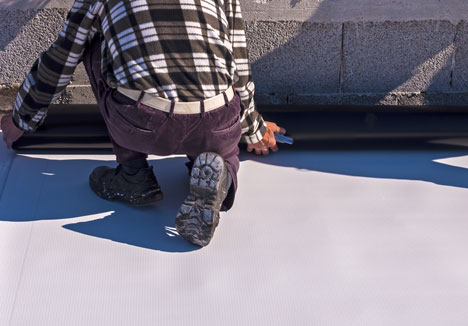
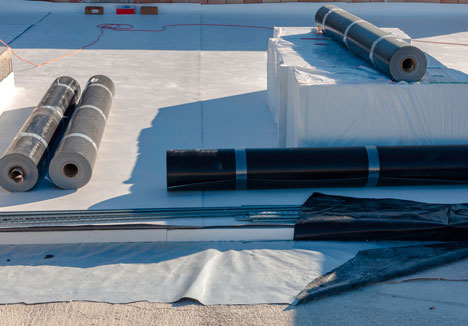
Single Ply roofing Thermosets
Single-ply roofing membranes can be generally categorized into two groups: thermosets and thermoplastics. Thermosets are materials that you can’t hot-air weld because the heat will change their physical characteristics. They need to be overlapped using a tape or a contact cement. According to SPRI, thermoset membranes are compounded from rubber polymers. The most commonly used polymer is EPDM (ethylene propylene diene monomer). EPDM membranes are known for their long-term weathering ability, and perform well even when subjected to fluctuations in temperature, ultraviolet rays, and ozone. Both unreinforced and reinforced membranes are available, the latter of which increases resistance to tearing. EPDM is available in thicknesses ranging from 30 mils to 90 mils. Many distributors make them available in wider sheets for bigger projects. EPDM is a popular choice for large roof areas because they can be found in sheets up to 50’ by 100’. This means that it can minimize the seams. While it’s true that wider sheets can reduce the number of seams on a roof, there has been some debate about whether long-term wind resistance could be compromised in mechanically fastened applications where wider sheets are used.
Although most people think of thermoplastic membranes when a cool, energy-efficient roof is mentioned, EPDM membranes can be energy-savers, too. The effectiveness of these membranes are taken to another level with the help of white, acrylic coatings. According to the Alexandria, VA-based EPDM Roofing Association (ERA), “In addition to the oils and polymers used to make an EPDM membrane, another ingredient is added to the mix to enhance UV resistance. In the case of a black membrane, carbon black is added, which converts UV rays into heat. In the case of a white membrane, in lieu of carbon black, titanium dioxide is typically used to reflect UV rays and prevent it from attacking the polymer.”
Hypalon is another thermoset, although it is quite different from EPDM. “Hypalon is a unique material because it is manufactured as a thermoplastic; but, because it cures over time, it becomes a thermoset. Hypalon materials are heat sealed at the seams,” explains SPRI. It’s important to note that, unlike thermoplastics, Hypalon becomes unweldable with age.
What goes into a Single Ply Roof repair & Thermoplastics
As opposed to thermosets, which require the use of adhesives, the seams on thermoplastic single-ply membranes can be hot-air welded together to form cohesive laps. When thermoplastic membranes cool, they return to their original material type. PVC and TPO are two of the most commonly installed thermoplastic single-ply roofing membranes. According to SPRI, “Most thermoplastic membranes are manufactured to include a reinforcement layer, usually polyester or fiberglass, which provides increased strength and dimensional stability.” Since these membranes are characteristically light in color, they provide excellent reflectivity, resulting in potential energy savings. PVC membranes are manufactured from a combination of PVC resin, stabilizers, pigments, fillers, plasticizers, biocides, and various processing aids. Unlike TPO membranes, which require additives to increase fire resistance, PVC membranes are natural fire retardants. While problems with PVC membranes back in the 1960s may have colored some facilities professionals’ views on these thermoplastic roofs, the use of chemical plasticizers that evaporated (causing embrittlement and shrinkage) have long since been discontinued.
The other popular thermoplastic membrane on the market today is TPO. “TPO polymers are blends or alloys of polypropylene plastic or polypropylene and ethylene propylene rubber (EPR) or ethylene propylene diene terpolymer rubber (EPDM),” SPRI reports.
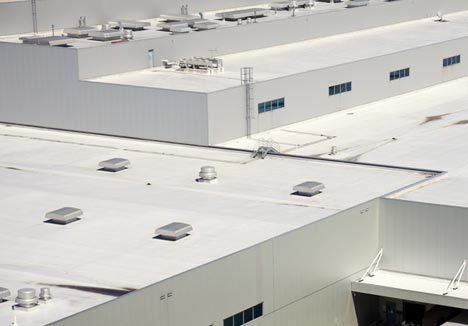
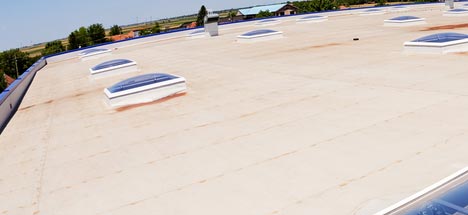
TPO can be installed in a multitude of ways. Plus, with the introduction of peel-and-stick products, installation time can be reduced significantly. Like PVC, TPO remains hot-air weldable throughout its service life, simplifying repairs and maintenance. This makes it a popular choice for homeowners, contractors, and business owners alike.
Fastening Methods:
Mechanically Fastened Roofing
There are a couple of different fastening methods that can be used for single-ply roofing installations. When considering the fastening method most appropriate for your application, it’s important to make a selection based upon a number of factors, including the type of roof deck (wood, metal, concrete, etc.) on your building. Mechanically fastened single-plies will work on just about any type of roof deck. Where you have to be careful is when you get into some of the very lightweight decks, such as the cementitious wood fiber and gypsum decks. You must also be cautious when using lightweight insulating concrete. This is because you’re relying on that material to hold the roof down. In many cases, manufacturers will recommend fastening through the insulating concrete into the structural deck. Some of these applications may require narrower sheets and more fasteners to ensure that there isn’t a greater likelihood of fastener pull-out (referred to as pull-out value).
Careful consideration should be given so that the proper number of fasteners is used. Installing a roof with an insufficient number of fasteners can increase the chances of blow-off. When one fastener pulls out, its load is transferred to surrounding fasteners, increasing the chances of their pull-out as well. If the facility is located in an area prone to high winds, it’s even more important that your single-ply roof is securely fastened onto your house.
If you’re in a wind zone or a place where you’re exposed to high wind uplift conditions (hurricanes, etc.), the fully adhered applications (with mechanical attachment at perimeters) tend to resist wind uplift better than mechanically attached.
Fully Adhered Roofing
With fully adhered systems, you’re totally reliant on the substrate that you’re adhering the membrane to [in order to] hold the roof on. You’re not using fasteners and plates or bars, you’re just gluing the membrane to the substrate – sometimes, that’s right to the deck material, insulation, and in some cases, an existing membrane. While mechanical fastening involves the expense of increased labor time and materials, fully adhered systems can be quite economical – especially when considering self-adhered products like peel-and-stick TPO.
Again, it’s important to think about the roof deck and its role in this decision. We don’t recommend mechanically attaching a roof – any kind of roof – to a concrete deck. We just don’t think it is the right thing to do (hammer-drilling holes in a concrete deck to attach the roof). Now, we do recommend adhering single-plies to a concrete deck with an adhesive. We think that’s an appropriate solution. While it’s not uncommon to mechanically fasten a roof to a concrete deck, fully adhered systems have been found to provide excellent wind uplift resistance in these applications. Additionally, various peel-and-stick TPO membranes must have a suitable substrate in order to bond properly.
Ballasted Roofing
While adding ballast to a loosely laid roof is most commonly associated with EPDM, other membranes can also take advantage of this fastening method. However, PVC is one membrane where it’s best to seek out an alternative means of installation. Ballasted roof systems just aren’t all that suited for PVC membranes. In the ’90s, the PVC industry abandoned the idea of a ballasted PVC, as it was thought that the silt associated with the ballast was to blame for extracting plasticizers from the membrane. Ballasted systems typically use aggregate that is 0.75 to 1.5 inches in diameter and is applied over a loosely laid membrane at 10 to 12 pounds per square foot. As an alternative to aggregate, 2-inch concrete pavers that can withstand freeze-and-thaw cycles can be applied over a non-woven fleece pad to anchor the membrane, keeping it in place.
According to ERA, “… generally, ballasted [EPDM] roofing systems have the lowest installed cost per square foot, followed by mechanically fastened and fully adhered systems.” However, cost alone shouldn’t be the deciding factor. Every method has its pros and cons. For instance, in the case of a ballasted system, a facility professional should be aware that locating the source of eventual leaks will be more challenging. An expert is also important to help determine if the weight of a ballasted system can be sustained. “I would advocate that you shouldn’t put a million pounds of rock up on a metal deck [or on] a building that has a lightweight deck. There are better ways to do it,” Weber explains.
As noted earlier, areas prone to high winds must take special precautions when designing and installing a ballasted system – or consider avoiding it altogether. Once upon a time, you used to be able to put a ballasted roof on buildings in Georgia. When hurricane season became a regular occurence, they completely outlawed it. It wasn’t because the roofs failed. It was because the rocks blew off, breaking all the glass in the surrounding buildings, and injuring any people nearby. A roof that poses such a threat to human life in such weather shouldn’t be installed in areas where it is susceptible to damage.
Single ply Roof Inspection & Repair
After storms and when tradespeople are doing rooftop work, make sure to survey the roof for potential damage. The best way to make sure your single-ply roofing membrane lives up to its 15- to 20-year life expectancy is to provide it with the TLC and properly installed roof repairs it may require. Call the pros at GA Roofing & Repair, Inc. for your next Atlanta commercial roofing project or new Single-Ply roofing system.
call us at!

